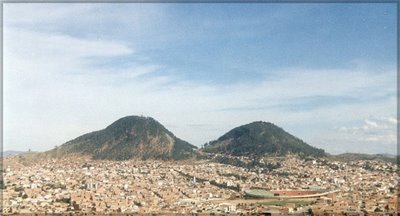


Tarabuco promocionará la festividad del Pujllay
Sucre, Con el objetivo de promocionar los atractivos turísticos de Tarabuco, el Gobierno Municipal ha iniciado la elaboración con su Plan de Desarrollo Turístico para que sea incorporado en el Programa de Operaciones Anuales 2007 y en el Plan de Desarrollo Municipal para los próximos cinco años.
La vestimenta y la música, la fiesta del Pujllay y la Batalla de Jumbate son los atractivos más visitados del municipio, sin embargo existen muchos más que deben ser incorporados es este plan, aseguró el concejal, René Rosales.
Este plan se construye con el apoyo de Programa de Apoyo a la Democracia Municipal (Padem) y la Asociación de Municipalidades de Chuquisaca (Amdech) y se pretende concluir hasta fines de noviembre.
Por primera vez el Municipio de Tarabuco elaborará un plan estratégico de turismo, demandado por las autoridades y dirigentes de esta región.
A decir de Rosales, esta planificación definirá claramente con qué proyectos de turismo puede acompañar el Gobierno Municipal y cuáles los beneficios y actores.
Actualmente, el municipio recibe cada domingo a un centenar de visitantes, entre turistas extranjeros y nacionales, sin embargo, afirma que “no queremos que vengan, saquen fotos a nuestros hermanos campesinos, compren algunos textiles y se vayan”.
Lo primero que sugiere el municipio para la elaboración de este plan es normar con cada uno de los operadores de turismo nacional e internacional para definir cuanto ingresa y cuanto debe quedarse en el municipio.
Otra de las fortalezas que tendrá esta estrategia, confirmó el concejal, será que permitirá la participación activa de los dirigentes y organizaciones sociales del municipio, fundamentalmente para la inscripción de ideas de proyecto en este tema turístico.
Tarabuco no cuenta con un inventario de sus atractivos turísticos, a pesar de esto, la fiesta del Pujllay, que se realiza en la tercera semana de marzo, es una de las más visitadas del país.
Rosales enfatizó que además del Pujllay, este municipio posee otras características como la cultura Ayarichi, el ecoturismo, la fiesta de navidad, las sendas prehispánicas, la cerámica y un calendario festivo que sólo es conocido por los pobladores de la región.
Sucre Historical Perspective
Perspectiva Historica de Sucre La Ciudad de los 4 Nombres:
The city of La Plata was founded by Pedro de Anzures, Marques de Campo Redondo, on November 30th, 1538. Its foundation was a result of mining activities overseen by Gonzalo Pizarro, who was interested in exploring the Eastern highland region of the Andean Cordillera. In 1559, Spanish king Felipe II commanded the foundation of the Audiencia de Charcas, with its headquarters in the city of La Plata with the purpose of administering the eastern territories. The Audiencia held judicial authority and executive powers and presided over the regions of what is now Paraguay, south-eastern Peru, northern Chile and Argentina, and most of Bolivia. On 1609, the city received an archbishopric, and granted it theological autonomy. That, along with the establishment of the University of San Xavier in 1624. During the 17th century, La Plata served as a legal, religious, and cultural center of the Spanish eastern territories. The first cry of Independence in the Americas took place in the city of La Plata May 25th, 1809. On August 6th, 1825 independence was declared and a new republic was born under the name Bolivia after its liberator Simón Bolivar. On August 11th, the name of the city of La Plata was changed to Sucre in honor of Mariscal Antonio Jose de Sucre, who along with Bolivar, fought for independence from Spanish rule.
The city of Sucre is also known as the City of Four Names, being those names La Plata, Charcas, Ciudad Blanca (White City), and Sucre. On December 13, 1991 UNESCO declared the Historic City of Sucre a "World Heritage Site" in recognition of its rich history and its wealth of colonial architecture.
By November 1996, Sucre had 157,775 inhabitants.
Climate
The city of Sucre is located at an altitude of 2,790 m above sea level. Its weather is mild and pleasant around 20 degrees Celsius (68 to 80 Fahrenheit all round year.)
Main Attractions
Casa de la Libertad: House located on the main plaza, where the declaration of independence of Bolivia was signed on august 6th, 1825. Portraits of presidents, military decorations, and documents are displayed.
Palacio de la Glorieta: Formerly an outstanding palace owned by the wealthy entrepreneur Don Francisco de Argandoña, it now serves as a military school.
Museo de la Recoleta: Established by the Franciscan Order in the early 16th century, this placed served as a convent, barracks, prison, and museum. Displays anonymous paintings from the 16th to 20th centuries.
Universidad Mayor de San Francisco Xavier: Founded on March 27th, 1624 by Padre Juan de Frías Herrán.
Biblioteca Nacional de Bolivia: Archivo Nacional. Contains documents of the Audiencia de Charcas and those of the republic. Includes documents from the XVI to the XX centuries.
Museo de Charcas: Displays paintings by Melchor Perez de Holguín as well as furniture handcrafted by native Indians.
Museo del Arte Moderno: Displays works of modern Bolivian painting and sculptures.
Museo Textil Etnográfico: Features art exhibitions, and art workshops.
Museo Antropológico: Displays skulls, pottery, mummies, and textiles from the eastern tribes of Bolivia.
Dinosaur Marks : Located 10 Km, north of the city of Sucre, this place depicts dinosaur footprints as wells as prehistoric plant and animal fossils.
Churches: The Cathedral, San Francisco, La Merced, San Miguel, Santa Mónica, San Lázaro, Santo Domingo.
Interesting Web Site to Visit:
http://whc.unesco.org/pg.cfm?cid=31&id_site=566
http://www.hamsucre.gov.bo/
No comments:
Post a Comment